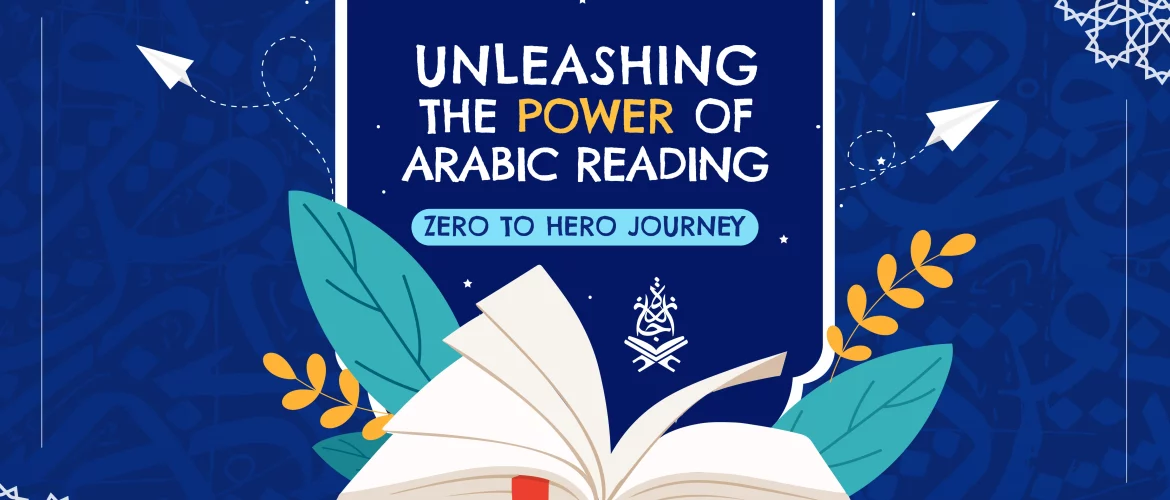Blog
Unleashing the Power of Arabic Reading: Zero to Hero Journey
- August 7, 2023
- Posted by: Tasneem Ragab
- Category: Blog Arabic Language

Arabic, a language of profound historical significance and cultural richness, holds a special place in the hearts of millions around the world. From the eloquent verses of the Quran to the intricate calligraphy adorning architectural wonders, Arabic is a testament to the beauty of language and human expression.
Embarking on a journey to master Arabic reading might seem like a daunting task, but with the right approach and dedication, anyone can transform from a novice to a proficient reader. In this blog post, we will delve into the steps of this transformative “Zero to Hero” journey in unleashing the power of Arabic reading.
Step 1: Embracing the Basics
Every journey begins with a single step, and the journey of Arabic reading is no different. Starting with the Arabic alphabet might feel overwhelming, but understanding the 28 letters and their various forms is the foundation of your progress. Begin with learning the shapes and sounds of individual letters, practicing their pronunciation until you’re comfortable with their distinct sounds and connected forms.
Step 2: Building Your Vocabulary – Arabic Reading

As you become more comfortable with the Arabic alphabet, start building your vocabulary. Choose common words and phrases that are relevant to your interests and daily life. Utilize flashcards, language learning apps, and reading materials to gradually expand your word bank. Remember, consistency is key; a little practice each day goes a long way.
Step 3: Grasping Grammar and Syntax
Arabic grammar may seem complex, but it’s an essential component of becoming a proficient reader. Learning sentence structure, verb conjugation, and noun-adjective agreements will significantly enhance your understanding of written Arabic. Invest time in studying grammar rules, and seek out resources like textbooks and online tutorials to guide you.
Step 4: Diving into Reading Materials
Now that you’ve built a solid foundation in the basics, it’s time to dive into actual reading materials. Start with simple texts such as children’s stories, news articles, or online blogs. Focus on comprehension rather than speed, gradually increasing the complexity of the texts as you become more confident. Reading aloud can help improve your pronunciation and fluency.
Step 5: Language Exchange and Conversation
To truly master a language, you need to engage in real-life conversations. Join language exchange groups or find native Arabic speakers to converse with. Engaging in conversations will expose you to colloquialisms, cultural nuances, and the rhythm of spoken Arabic. This step is crucial for transitioning from a reader to a holistic language user.
Step 6: Immersing in Arabic Media

Immersing yourself in Arabic media is a dynamic way to enhance your reading skills. Watch Arabic movies, TV shows, listen to podcasts, and follow social media accounts that use the language. Over time, your brain will adapt to the sounds and cadences of Arabic, further improving your reading comprehension and listening skills.
Step 7: Embracing Challenges
Challenges are inherent in any learning journey, but they are where growth happens. Don’t be discouraged by difficult texts or moments of confusion. Embrace them as opportunities to expand your knowledge and refine your skills. Keep a journal to track your progress and reflect on your achievements.
Step 8: Cultural Exploration
Language and culture are deeply intertwined. As you progress in your Arabic reading journey, take time to explore the rich cultural heritage of Arabic-speaking countries. Learn about traditions, cuisine, history, and art. This will not only enrich your understanding of the language but also provide a broader perspective on the world.
Step 9: Seeking Advanced Learning
Becoming a hero in Arabic reading doesn’t mean the journey ends. As you reach advanced levels, consider formal language classes or even studying abroad in an Arabic-speaking country. Engaging with advanced texts and literature will challenge and inspire you to reach new heights of linguistic proficiency.
Step 10: Celebrating Small Wins
Learning Arabic—or any language—isn’t just about reaching the finish line; it’s about acknowledging every little milestone along the way. Did you read your first Arabic sentence without looking up a single word? That’s a win. Did you finally figure out when to use “wa” versus “fa”? Celebrate it. These small victories keep you motivated and remind you of the progress you’ve made. Language learning isn’t a sprint, so savor the journey and every breakthrough moment.
Step 11: Personalizing Your Learning Path

No two learners are the same, and what works for one person might not work for another. Tailor your learning experience to suit your style. If you’re a visual learner, create color-coded charts for vocabulary and grammar. If you learn by doing, write short paragraphs in Arabic or try translating simple texts. By personalizing your approach, you’ll not only stay engaged but also find joy in the process. This isn’t about following a rigid plan—it’s about making the language part of your world.
Step 12: Revisiting and Reinforcing
Learning Arabic is like building a house: without a strong foundation, the structure won’t hold. Revisit the basics often, even if you feel you’ve outgrown them. Review the alphabet, basic grammar, and essential vocabulary regularly to reinforce what you know. You’d be surprised how much a quick refresh can solidify your skills and fill in gaps you didn’t even realize were there.
Step 13: Reading for Pleasure
Once you’ve gained confidence with basic texts, start exploring materials that genuinely interest you. Love poetry? Dive into Arabic verses. Enjoy cooking? Try reading Arabic recipes. Into current events? Follow Arabic news outlets. When you engage with topics you’re passionate about, reading feels less like a task and more like a treat. Plus, you’ll pick up useful vocabulary that aligns with your interests, making it easier to retain.
Step 14: Keeping It Fun and Creative
Language learning doesn’t have to be all drills and exercises. Find creative ways to keep it fun. Play word games in Arabic, write short stories, or challenge yourself to decipher Arabic signs or menus. The more you enjoy the process, the more natural it will feel to incorporate Arabic into your daily life. Remember, the goal isn’t just proficiency—it’s building a connection with the language that lasts.
Final Thoughts: The Journey of Arabic Reading That Never Truly Ends
Learning Arabic isn’t about “finishing.” It’s about continuously discovering, growing, and connecting. The beauty of this journey lies in its endless opportunities to learn more, understand deeper, and connect with a language that’s both ancient and alive in the modern world.
Whether you’re reading a classic piece of literature, chatting with a friend over tea, or simply deciphering a sign on a bustling street, every moment with Arabic is a chance to see the world through a different lens. So, take your time, stay curious, and enjoy every step of this remarkable journey.
You’ve got this—and if you ever feel stuck, remember why you started. Arabic has a way of rewarding patience with beauty, and every new word or phrase you learn is a step closer to unlocking that richness.
